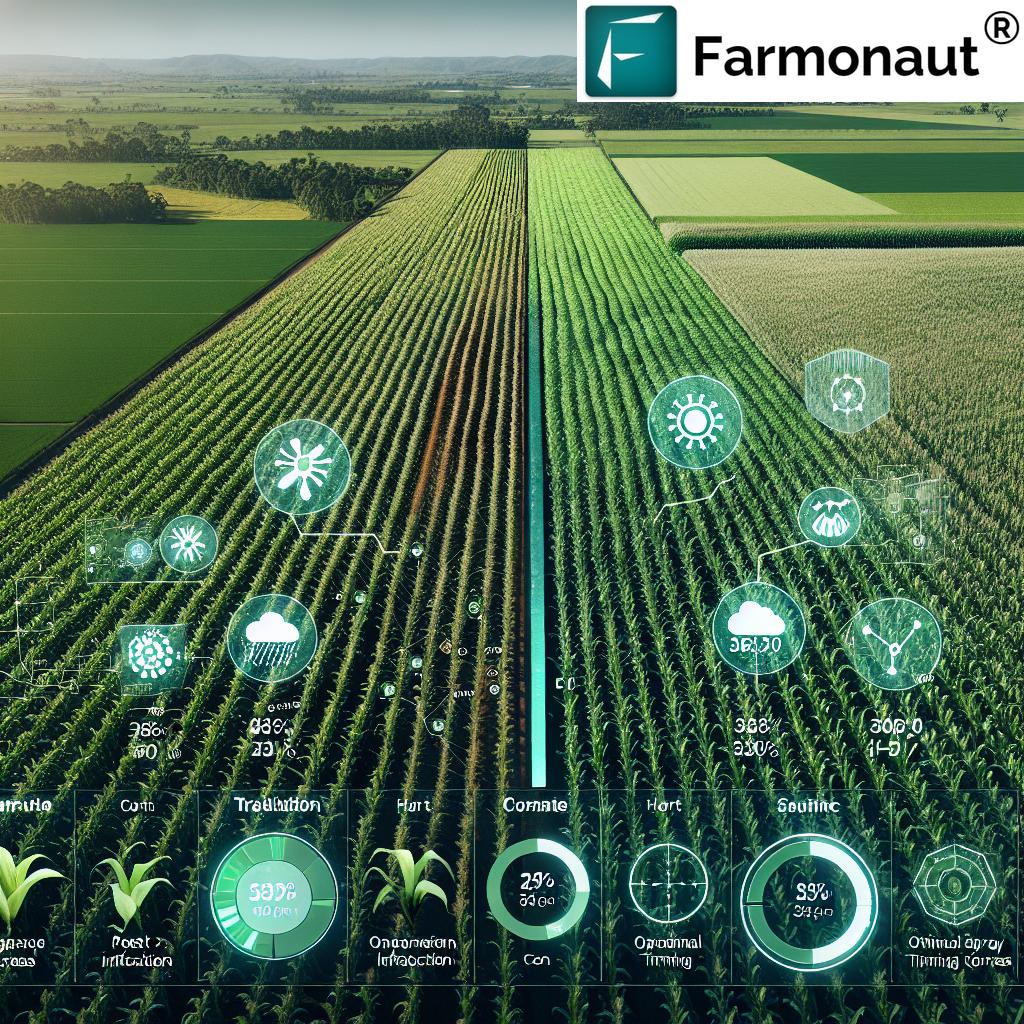Mastering Corn Earworm Resistance: A Comprehensive Guide to Integrated Pest Management in Australian Sweet Corn Crops
“Corn earworm resistance management is crucial during the silking stage, which typically lasts 18-21 days in sweet corn crops.”
Welcome to our comprehensive guide on mastering corn earworm resistance in Australian sweet corn crops. As experts in sustainable agriculture and integrated pest management, we at Farmonaut understand the critical importance of effective corn earworm management and sweet corn pest control. In this blog post, we’ll explore a range of strategies to combat Helicoverpa armigera resistance, with a particular focus on the crucial silking stage of crop development.

Understanding the Corn Earworm Threat
The corn earworm, scientifically known as Helicoverpa armigera, is a formidable pest that poses a significant threat to sweet corn crops across Australia. This voracious insect, also known as heliothis, can cause substantial damage to corn yields if left unchecked. As climate change continues to impact our agricultural landscape, the pressure from this pest is expected to intensify, making effective management strategies more crucial than ever.
The Importance of Integrated Pest Management in Crops
Integrated Pest Management (IPM) is a holistic approach to pest control that combines various strategies to minimize crop damage while reducing reliance on chemical interventions. For corn earworm management, IPM is particularly effective as it addresses the complex nature of pest resistance and helps maintain a balance between pest control and environmental stewardship.
Key Components of IPM for Corn Earworm Resistance:
- Pest monitoring techniques
- Biological control methods
- Cultural practices
- Judicious use of insecticides
- Crop rotation
By implementing a comprehensive IPM strategy, farmers can significantly reduce the risk of corn earworm infestations while promoting sustainable agriculture practices.
Pest Monitoring Techniques for Early Detection
Effective pest monitoring is the cornerstone of any successful IPM program. For corn earworm management, regular scouting and the use of pheromone traps are essential. These techniques allow farmers to detect pest populations early, enabling timely interventions before significant damage occurs.
Advanced Monitoring with Farmonaut Technology
At Farmonaut, we offer cutting-edge satellite-based crop health monitoring that can revolutionize your pest management efforts. Our technology provides real-time insights into vegetation health, allowing for early detection of potential pest infestations.
Explore our advanced monitoring solutions:
Biological Control Methods for Sustainable Pest Management
Biological control is a key component of sustainable agriculture practices. For corn earworm resistance management, several biological insecticides and natural predators can be employed effectively.
Bacillus thuringiensis (Bt)
Bt is a naturally occurring soil bacterium that produces proteins toxic to certain insects, including corn earworms. When applied to crops, Bt acts as a biological insecticide, offering an environmentally friendly alternative to chemical pesticides.
Nuclear Polyhedrosis Virus (NPV)
NPV is a highly specific biological control agent that targets Helicoverpa armigera. This virus infects and kills corn earworm larvae, providing effective control without harming beneficial insects.
“Rotating between 3-4 different insecticide classes can reduce the risk of corn earworm developing resistance by up to 50%.”
Insecticide Rotation Strategy for Resistance Management
While biological control methods are essential, judicious use of insecticides remains a critical component of corn earworm management. Implementing an effective insecticide rotation strategy is crucial to prevent the development of resistance in pest populations.
Key Insecticides for Rotation:
- Spinetoram
- Chlorantraniliprole
- Methomyl
- Emamectin benzoate
- Thiodicarb
By rotating between different insecticide classes, farmers can significantly reduce the risk of resistance development in corn earworm populations.

Silking Stage: The Critical Period for Pest Control
The silking stage is a crucial period for corn earworm management in sweet corn crops. During this stage, which typically lasts 18-21 days, corn plants are particularly vulnerable to earworm infestations. Implementing targeted control measures during this period is essential for protecting crop yields.
Strategies for Silking Stage Pest Management:
- Increased monitoring frequency
- Timed foliar spray applications
- Use of pheromone traps to track adult moth activity
- Implementation of biological control agents
By focusing pest control efforts during the silking stage, farmers can significantly reduce crop damage and improve overall yields.
Climate Change and Its Impact on Pest Pressure
As climate change continues to alter weather patterns and temperatures, pest pressure is expected to increase in many agricultural regions. For corn earworm management, this means adapting strategies to account for longer growing seasons and potentially more generations of pests per year.
Adapting to Climate Change:
- Adjusting planting dates to avoid peak pest periods
- Implementing climate-resilient crop varieties
- Enhancing monitoring systems to detect shifts in pest patterns
- Developing region-specific IPM strategies
By staying informed about climate trends and their potential impacts on pest populations, farmers can proactively adjust their management strategies to maintain effective control.
Stewardship in Crop Protection: Balancing Efficacy and Environmental Responsibility
Effective corn earworm management goes hand in hand with responsible stewardship practices. As farmers and agricultural professionals, it’s our duty to implement pest control methods that not only protect our crops but also minimize environmental impact.
Key Stewardship Practices:
- Proper handling and application of insecticides
- Implementing buffer zones to protect water sources
- Promoting biodiversity to support natural pest control
- Adhering to integrated pest management principles
By embracing these stewardship practices, we can ensure the long-term sustainability of our agricultural systems while effectively managing corn earworm resistance.
Farmonaut’s Role in Enhancing Pest Management
At Farmonaut, we’re committed to providing innovative solutions that support effective pest management and sustainable agriculture. Our advanced satellite-based crop monitoring technology offers farmers unprecedented insights into crop health and potential pest infestations.
How Farmonaut Can Help:
- Early detection of crop stress that may indicate pest presence
- Real-time vegetation health monitoring
- AI-driven advisory system for pest management recommendations
- Integration with weather data for optimal spray timing
Explore our mobile apps for on-the-go crop monitoring:
Managing Fall Armyworm: An Emerging Threat
While our focus has been on corn earworm, it’s important to note that fall armyworm (Spodoptera frugiperda) has emerged as a significant threat to corn crops in recent years. Many of the strategies discussed for corn earworm management can also be effective against fall armyworm infestations.
Key Considerations for Fall Armyworm Control:
- Early detection through regular scouting
- Use of pheromone traps specific to fall armyworm
- Implementation of biological control agents like Bt
- Targeted insecticide applications when necessary
By staying vigilant and adapting our pest management strategies, we can effectively address both corn earworm and fall armyworm threats to our crops.
Integrated Pest Management Strategies Table
| Strategy | Description | Effectiveness | Environmental Impact |
|---|---|---|---|
| Insecticide Rotation | Alternating between different insecticide classes to prevent resistance | High | Moderate |
| Bacillus thuringiensis (Bt) | Biological insecticide targeting specific pests | Medium | Low |
| Nuclear Polyhedrosis Virus (NPV) | Virus-based control specific to Helicoverpa armigera | Medium | Low |
| Pest Monitoring | Regular scouting and use of pheromone traps | High | Low |
| Climate-Adaptive Practices | Adjusting planting dates and using resilient crop varieties | Medium | Low |
| Spinetoram Application | Targeted insecticide for lepidopteran pests | High | Moderate |
| Chlorantraniliprole Treatment | Broad-spectrum insecticide effective against various pests | High | Moderate |
The Role of Biotechnology in Pest Resistance
Biotechnology plays an increasingly important role in developing crop varieties with enhanced resistance to pests like corn earworm. Genetically modified (GM) corn varieties that express Bt proteins have shown significant promise in reducing pest damage and decreasing reliance on chemical insecticides.
Benefits of Bt Corn:
- Reduced need for foliar insecticide applications
- Season-long protection against target pests
- Minimal impact on non-target organisms
- Potential for increased yields and improved crop quality
While GM crops are subject to regulatory approval and may not be suitable for all farming systems, they represent an important tool in the integrated pest management toolkit.
Timing Foliar Sprays for Maximum Effectiveness
When chemical interventions are necessary, timing is crucial for maximizing efficacy and minimizing environmental impact. For corn earworm management, foliar sprays should be timed to coincide with peak pest activity and vulnerable crop stages.
Best Practices for Foliar Spray Timing:
- Monitor pest populations using pheromone traps
- Apply sprays during early morning or late evening to reduce drift
- Consider weather conditions to ensure optimal coverage
- Adhere to pre-harvest intervals to maintain food safety
By carefully timing foliar spray applications, farmers can achieve better pest control while minimizing the risk of resistance development.
Leveraging Farmonaut’s API for Enhanced Pest Management
For agricultural professionals and developers looking to integrate advanced crop monitoring capabilities into their own systems, Farmonaut offers a powerful API solution. Our API provides access to satellite imagery, weather data, and AI-driven insights that can significantly enhance pest management efforts.
Explore our API capabilities:
Farmonaut API
API Developer Docs
Sustainable Agriculture: Balancing Productivity and Environmental Protection
As we strive to meet the growing global demand for food, feed, and fibre, it’s crucial to balance productivity with environmental protection. Sustainable agriculture practices, including effective pest management strategies, play a vital role in achieving this balance.
Key Aspects of Sustainable Corn Production:
- Soil conservation techniques
- Water-efficient irrigation systems
- Integrated pest management
- Crop rotation and diversification
- Minimizing chemical inputs
By adopting these practices, farmers can maintain high yields while preserving the long-term health of their land and surrounding ecosystems.
The Future of Corn Earworm Management
As we look to the future, the landscape of corn earworm management is likely to evolve with advancing technologies and changing environmental conditions. Staying informed about emerging trends and innovations will be crucial for maintaining effective pest control strategies.
Emerging Trends in Pest Management:
- Precision agriculture technologies for targeted pest control
- Development of new biopesticides and biological control agents
- Advanced predictive models for pest forecasting
- Integration of drone technology for pest monitoring and spray applications
By embracing these innovations and continuing to refine our integrated pest management approaches, we can ensure the long-term sustainability and productivity of our sweet corn crops.
Conclusion: A Holistic Approach to Corn Earworm Resistance
Mastering corn earworm resistance in Australian sweet corn crops requires a multifaceted approach that combines traditional farming wisdom with cutting-edge technology. By implementing comprehensive integrated pest management strategies, leveraging advanced monitoring tools like those offered by Farmonaut, and staying committed to sustainable agriculture practices, farmers can effectively protect their crops while minimizing environmental impact.
Remember, successful pest management is an ongoing process that requires vigilance, adaptability, and a commitment to continuous learning. By staying informed about the latest research, technologies, and best practices, we can work together to ensure the resilience and productivity of our agricultural systems for generations to come.
Farmonaut Subscriptions
Frequently Asked Questions (FAQ)
Q: What is the most critical stage for corn earworm management in sweet corn crops?
A: The silking stage, which typically lasts 18-21 days, is the most critical period for corn earworm management in sweet corn crops.
Q: How can farmers detect corn earworm infestations early?
A: Early detection can be achieved through regular scouting, the use of pheromone traps, and advanced monitoring technologies like Farmonaut’s satellite-based crop health monitoring system.
Q: What are some effective biological control methods for corn earworm?
A: Effective biological control methods include the use of Bacillus thuringiensis (Bt) and Nuclear Polyhedrosis Virus (NPV), which target corn earworm without harming beneficial insects.
Q: How does climate change affect corn earworm management?
A: Climate change can lead to longer growing seasons and potentially more generations of pests per year, requiring farmers to adapt their management strategies and enhance monitoring systems.
Q: What role does biotechnology play in corn earworm resistance?
A: Biotechnology has led to the development of genetically modified (GM) corn varieties that express Bt proteins, providing season-long protection against target pests and reducing the need for chemical insecticides.






